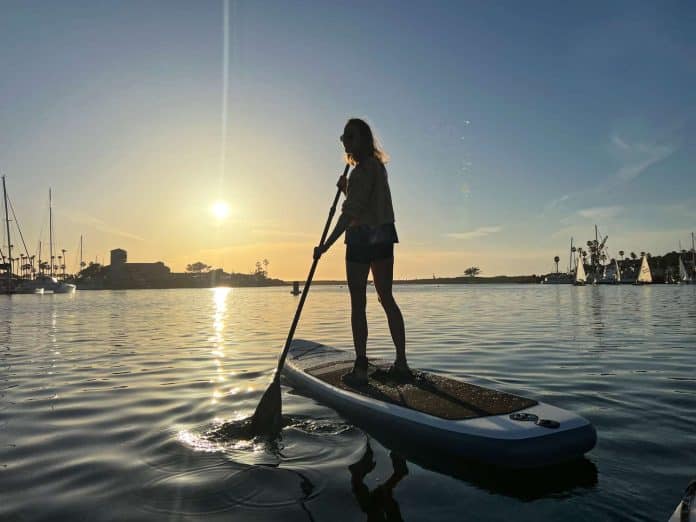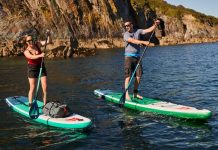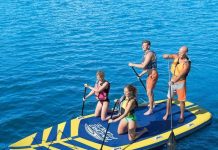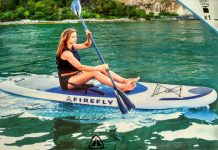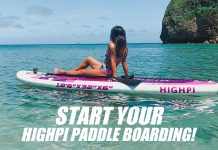Non-inflatable paddle boards are becoming increasingly popular among water sports enthusiasts due to their superior speed, handling, glide, and efficiency through the water.
Unlike their inflatable counterparts, non-inflatable paddle boards are rigid and provide a more stable platform for riders. They are especially suitable for big waves and racing, where speed and agility are essential.
If you’re in the market for a non-inflatable paddle board, there are a few things to consider before making your purchase. First and foremost, you’ll want to consider the type of paddle boarding you plan on doing.
Are you looking for a board that can handle big waves and racing, or are you more interested in leisurely paddling on calm waters?
The answer to this question will help you determine the size and shape of the board that’s right for you.
Additionally, you’ll want to consider the materials used to construct the board, as this can significantly impact its durability and performance.
Understanding Paddle Boarding
Paddleboarding is a water sport that involves standing on a board and using a paddle to move across the water. It’s a fun activity that can be done on various water bodies, including oceans, lakes, rivers, and dams.
Paddleboarding is a low-impact and full-body workout that people of all ages and fitness levels can enjoy.
Paddleboards come in two main types: inflatable and non-inflatable. Non-inflatable paddle boards are made of solid materials like epoxy, fiberglass, or carbon fiber.
They are more rigid and offer better performance in the water, making them ideal for surfing and racing. In contrast, inflatable paddle boards are made of PVC or other durable materials and can be inflated and deflated for easy storage and transport.
When paddleboarding, it’s essential to consider the water conditions and choose the appropriate board. In calm waters, a broader and more stable board is recommended, while in choppy waters, a narrower and more maneuverable board is preferred.
For surfing, a shorter board with a pointed nose and a rocker is ideal, while for racing, a longer and narrower board with a displacement hull is recommended.
In addition to the board, the paddle is also an essential factor to consider. The paddle should be the right length and weight for the individual’s height and strength.
A longer paddle is recommended for taller individuals, while a shorter paddle is better for shorter individuals. The paddle blade should also be considered, with a larger blade providing more power and a smaller blade offering more control.
Overall, paddleboarding is a versatile and enjoyable sport that can be enjoyed by anyone who loves being in the water. Whether surfing, racing, or cruising, there is a paddleboard for every type of paddler.
Types of Paddle Boards
Paddleboarding is a fun and exciting activity that people of all ages and skill levels can enjoy.
Several types of paddle boards are available in the market, each designed to cater to the rider’s specific needs.
Hard Boards
Rigid boards are the traditional type of paddle boards that are made of materials like wood, fiberglass, or foam. These boards are known for their durability, stability, and speed.
They are ideal for advanced riders who want to withstand challenging conditions like big waves or strong currents. Rigid boards are also great for touring, racing, and fitness paddling.
Surfboards
Surfboards are a type of paddle board that is designed for surfing. These boards are shorter and narrower than traditional paddle boards and have a pointed nose and tail.
They are lightweight and easy to maneuver, making them ideal for catching waves. Surfboards are not recommended for beginners as they require a specific skill and experience.
SUPs
SUPs, or Stand-Up Paddleboards, are the most popular type of paddleboard. They are versatile and can be used for touring, fishing, yoga, and racing. SUPs come in different shapes and sizes, with some being wider and more stable than others. They can be made of foam, fiberglass, or carbon fiber.
Inflatable Paddle Boards
Inflatable paddle boards or iSUPs are a type of paddle board that can be inflated and deflated for easy storage and transportation. They are made of durable materials like PVC and are designed to be lightweight and easy to carry.
Inflatable paddle boards are great for beginners as they are more stable and forgiving than rigid boards. They are also ideal for traveling as they can be packed in a backpack or a suitcase.
In conclusion, several types of paddle boards are available in the market, each designed to cater to the rider’s needs. Whether you are a beginner or an advanced rider, there is a paddle board out there that is perfect for you.
Non-Inflatable vs. Inflatable Paddle Boards
When choosing between a non-inflatable and inflatable paddle board, there are several factors to consider.
The most significant difference between the two is the feeling of the water. One is stiff, while the other is softer. As a result, the stiffer rigid board also performs much faster than the softer inflatable.
Non-inflatable paddle boards are typically made from foam or PVC, which makes them rigid and durable. They are less susceptible to punctures and can withstand rougher conditions. In contrast, inflatable paddleboards are made from military-grade PVC and are lightweight, easy to carry around and repair, and durable. They are also easier to store and transport when deflated.
Stability is another factor to consider. A solid board is a tad more rigid than an inflatable board, which can provide a more stable feel, especially when riding waves. Solid boards also tend to ride lower in the water, which can also create a more stable feel.
When it comes to weight, inflatable paddle boards are generally lighter than non-inflatable paddle boards. This makes them easier to carry around and transport but can also make them less stable in rougher conditions. Non-inflatable boards are heavier but more stable and provide a smoother glide.
In terms of durability, both non-inflatable and inflatable paddle boards are built to last. Non-inflatable boards are typically made from high-quality materials that withstand the elements and rough conditions. Inflatable boards, on the other hand, are made from military-grade PVC and are designed to be puncture-resistant and durable.
Choosing between a non-inflatable and inflatable paddle board depends on personal preference and the paddling you plan to do.
If you’re looking for a board that is easy to transport and store, an inflatable board may be the better choice. A non-inflatable board may be better if you want a more stable board that provides a smoother glide.
ISLE Versa Rigid Stand Up Paddle Board & SUP Bundle Accessory Pack — Hard Board Lightweight Epoxy SUP — 215 Pound Capacity, 10’5” Long x 32" Wide x 4.5” Thick, Coral
Materials and Construction
Non-inflatable paddle boards are typically made of a combination of materials, including fiberglass, wood, kevlar, carbon fiber, foam core, bamboo, and drop stitch. The construction of a paddle board can significantly affect its performance, durability, and weight.
Most solid paddle boards are made of fiberglass and epoxy resin layers over hollow wood or foam cores. Some high-end paddle boards are made of carbon fiber over foam cores.
Wood is a popular material for paddle boards due to its natural beauty and durability, but it is also heavier than other materials. Kevlar is a strong and lightweight material that is often used in the construction of racing paddle boards.
Foam cores are commonly used to construct paddle boards due to their lightweight and buoyant properties. Drop stitch construction involves thousands of tiny threads connecting the board’s top and bottom layers and is a popular construction method for inflatable paddle boards.
The rails of a paddle board are also an essential aspect of its construction. Rails are the edges of the board that run along the length of the board.
They can be made of various materials, including wood, fiberglass, and carbon fiber. Reinforcing strips can also be added to the rails to increase the board’s rigidity.
In summary, the materials and construction of a paddle board significantly affect its performance, durability, and weight. Non-inflatable paddle boards can be made of various materials, including fiberglass, wood, kevlar, carbon fiber, foam core, bamboo, and drop stitch.
Foam cores and drop stitch construction are commonly used to construct paddle boards due to their lightweight and buoyant properties.
Rails are essential to a paddle board’s construction and can be made of various materials, including wood, fiberglass, and carbon fiber.
ISLE Versa Rigid Stand Up Paddle Board & SUP Bundle Accessory Pack — Hard Board Lightweight Epoxy SUP — 215 Pound Capacity, 10’5” Long x 32" Wide x 4.5” Thick, White/Blue
Lifetime Amped Hardshell Paddleboard with Paddle, 11', Glacier Blue
$550.00 in stock
Size and Shape
Regarding non-inflatable paddle boards, sizeddshapeiarea ialfactoreconsidernbeforebefore purchasing.
The size and shape of a paddle board will affect its performance, stability, and maneuverability in the water.
Length
The length of a non-inflatable paddle board typically ranges from 8 feet to 14 feet. Longer boards are faster and more efficient, making them ideal for touring and racing.
However, they can be more challenging to maneuver and turn. On the other hand, shorter boards are more maneuverable, making them suitable for surfing and recreational paddling.
Width
The width of a non-inflatable paddle board ranges from 28 inches to 36 inches. Wider boards provide more stability, making them ideal for beginners and those who want to do yoga or fishing on their paddle board. However, they can be slower and less efficient.
Narrower boards are faster and more efficient, making them ideal for touring and racing. However, they can be less stable, making them more challenging for beginners.
Shape
The shape of a non-inflatable paddle board can be classified into three categories: planing hull, displacement hull, and hybrid hull. Planing hulls are flat and wide, providing maximum stability and maneuverability.
They are ideal for beginners and recreational paddling. Displacement hulls are pointed and narrow, providing maximum speed and efficiency. They are ideal for touring and racing. Hybrid hulls combine the features of planing and displacement hulls, providing a balance between stability and speed.
Volume and Thickness
The volume and thickness of a non-inflatable paddle board are also essential factors to consider. The volume of a paddle board determines its buoyancy, while the thickness determines its rigidity.
Most non-inflatable paddle boards are around 6 inches thick, providing a good balance between rigidity and weight. However, thicker boards can provide more stability, while thinner boards can be more efficient.
In summary, the size and shape of a non-inflatable paddle board are crucial factors to consider before purchasing.
The length and width of the board will affect its stability, maneuverability, and speed, while the shape will affect its performance in different water conditions. The volume and thickness of the board will affect its buoyancy and rigidity.
Performance and Maneuverability
Non-inflatable paddle boards are known for their superior performance and maneuverability compared to inflatable paddle boards. They have a more direct energy transfer from the paddler to the board, resulting in better speed and response.
This makes them ideal for surfing, racing, and other high-performance activities.
When it comes to speed, non-inflatable paddle boards are faster than inflatable ones due to their hard shell construction. They effortlessly glide through the water, allowing paddlers to cover more distance in less time. This makes them perfect for long-distance paddling and racing.
In maneuverability, non-inflatable paddle boards are more responsive than inflatable ones. They are easier to turn and control, making them ideal for surfing and other activities that require quick and precise movements. This is because non-inflatable paddle boards have a more rigid construction, which allows them to respond quickly to the paddler’s movements.
Additionally, non-inflatable paddle boards are more stable than inflatable ones. They have a lower center of gravity, which makes them less likely to tip over or wobble in the water. This makes them an excellent choice for beginners or anyone who wants a more stable ride.
Overall, non-inflatable paddle boards are the preferred choice for anyone who values performance and maneuverability. They are faster, more responsive, and more stable than inflatable paddle boards, making them ideal for various activities. Whether you’re looking to surf, race, or paddle around, a non-inflatable paddle board is the way to go.
ISLE Versa Rigid Stand Up Paddle Board & SUP Bundle Accessory Pack — Hard Board Lightweight Epoxy SUP — 215 Pound Capacity, 10’5” Long x 32" Wide x 4.5” Thick, White/Blue
Lifetime Amped Hardshell Paddleboard with Paddle, 11', Glacier Blue
$550.00 in stock
Suitability for Skill Levels
Non-inflatable paddle boards suit all skill levels, from beginners to experts. However, the type of board best for each skill level may vary.
Beginners may want to consider broader and longer boards, as they provide more stability and are easier to balance. Some good beginner options include the ISLE Cruiser Soft Top SUP and the Pau Hana Malibu Classic.
Advanced paddlers may prefer more maneuverable and responsive boards, such as the Boardworks Versa – All Around SUP or the Surftech Generator. These boards are designed to handle various conditions and are great for exploring different waterways.
Expert paddlers may want to consider boards explicitly designed for their skill levels, such as the Tom Carroll Paddle Surf OUTER REEF – MX or the BOTE Flood Paddle Board. These boards are designed to handle more challenging conditions and provide the performance and stability that expert paddlers need.
Overall, non-inflatable paddle boards are an excellent option for all skill levels. It is essential to choose a board that is appropriate for your skill level and the conditions that you will be paddling in. By doing so, you can ensure that you have a safe and enjoyable paddling experience.
ISLE Versa Rigid Stand Up Paddle Board & SUP Bundle Accessory Pack — Hard Board Lightweight Epoxy SUP — 215 Pound Capacity, 10’5” Long x 32" Wide x 4.5” Thick, Coral
Features and Accessories
Non-inflatable paddle boards have various features and accessories that enhance their performance and convenience.
These features and accessories can significantly impact the overall experience of using a non-inflatable paddle board.
Deck Pad
A deck pad is a cushioned surface that covers the top of the paddle board, providing a comfortable and non-slip surface for the user.
Most non-inflatable paddle boards come with a deck pad made of EVA foam, which is durable and provides excellent traction. The deck pad can come in various thicknesses and textures, depending on the brand and model of the paddle board.
Grip
The grip is a handle located in the center of the paddle board that allows the user to carry the board quickly.
Most non-inflatable paddle boards come with a grip made of neoprene or other soft materials that are comfortable to hold and do not cause discomfort to the user.
Accessories
Non-inflatable paddle boards come with various accessories that can enhance the user’s experience. These accessories can include a backpack or carrying bag, bungee cord, safety leash, and GoPro mount.
The backpack or carrying bag allows the user to transport the paddle board easily, while the bungee cord provides a convenient way to store gear on the board.
The safety leash is an essential accessory that attaches the user to the board, preventing the board from drifting away if the user falls off. The GoPro mount allows the user to capture their adventures on the water.
Aluminum Paddle
An aluminum paddle is a standard accessory with most non-inflatable paddle boards. The paddle is adjustable, allowing the user to adjust the length. The aluminum material is lightweight and durable, making it easy to use and transport.
In conclusion, non-inflatable paddle boards come with various features and accessories that can enhance the user’s experience.
These features and accessories include a deck pad, grip, backpack or carrying bag, bungee cord, safety leash, and GoPro mount. The aluminum paddle is a standard accessory with most non-inflatable paddle boards.
Storage and Transport
Non-inflatable paddle boards are typically solid structures that require proper storage and transport.
Improper storage and transportation can cause damage to the board, which can be costly to repair or replace. Therefore, storing and transporting your non-inflatable paddle board is essential.
Storage
Keeping a non-inflatable paddle board in a dry, cool place, out of direct sunlight, is essential. Direct sunlight can cause the board to fade or even warp over time.
Therefore, it is best to store the board indoors, preferably on a SUP storage rack. A SUP storage rack is a convenient and safe way to store a paddle board, as it keeps the board off the ground and out of harm’s way.
Before storing the board, it is crucial to clean it thoroughly with fresh water to remove any dirt, sand, salt, or grime.
A mild soap and water mix can be used twice a year to wash the board. However, avoiding solvents or strong chemicals that could damage the board is essential. Once the board is clean, let it dry completely before storing it.
Transport
Transporting a non-inflatable paddle board requires more effort than an inflatable one. First, having the right vehicle to transport the board is essential. A roof rack or a truck bed is the best transport for a non-inflatable paddle board.
When transporting the board, it is crucial to secure it properly to prevent it from moving around during transport. A board bag or sock can protect the board from scratches and dings during transport.
It is important to note that non-inflatable paddle boards can be bulky and heavy, making them challenging to transport. Therefore, it is essential to have a plan for transporting the board before purchasing it. This includes having enough storage space and ensuring the board is portable for transportation.
In summary, proper storage and transport are crucial for maintaining the longevity of a non-inflatable paddle board. Storing the board in a dry, cool place and securely in a roof rack or truck bed is the best way to ensure the board stays in good condition.
Price and Value
When purchasing a non-inflatable paddle board, there are several factors to consider. One of the most important considerations is the price.
Non-inflatable paddle boards can range in price from a few hundred dollars to several thousand dollars. The price of a non-inflatable paddle board is typically determined by the materials used to construct the board, the size of the board, and the brand.
While it may be tempting to opt for the cheapest non-inflatable paddle board available, it is essential to consider the value of the board as well.
A board that is too cheap may be made from lower-quality materials and may not perform as well as a higher-priced board. On the other hand, a board that is too expensive may not provide enough additional features or benefits to justify the higher price tag.
When considering the price and value of a non-inflatable paddle board, it is essential to consider its intended use. If the board will be used frequently and for various activities, it may be worth investing in a higher-priced board that offers additional features and benefits. However, a more reasonably priced board may be a better option if the board will only be used occasionally or for a specific activity.
Overall, the price and value of a non-inflatable paddle board is a personal decision that should be based on individual needs and preferences. Researching and comparing different brands and models is essential to find the board that offers the best balance of price and value.
ISLE Versa Rigid Stand Up Paddle Board & SUP Bundle Accessory Pack — Hard Board Lightweight Epoxy SUP — 215 Pound Capacity, 10’5” Long x 32" Wide x 4.5” Thick, White/Blue
Lifetime Amped Hardshell Paddleboard with Paddle, 11', Glacier Blue
$550.00 in stock
Specialized Paddle Boards
Non-inflatable paddle boards come in various shapes and sizes that cater to different activities.
Some paddle boards are designed for touring, fishing, racing, and more. Specialized paddle boards are built with specific features to enhance the user’s experience in a particular activity.
Touring Boards
Touring paddle boards are designed for long-distance paddling, making them perfect for exploring the open waters. They are typically longer and narrower than most paddle boards, which helps them glide smoothly through the water.
Touring boards also have a pointed nose that cuts through the water, reducing drag and increasing speed. The Tom Carroll Paddle Surf Outer Reef – MX is an excellent example of a touring board with double concave contours for added stability and speed.
Fishing Boards
Fishing paddle boards are designed with features that make them ideal for fishing. They are broader and more stable than most paddle boards, allowing anglers to stand on them comfortably while casting their lines.
Fishing boards also have extra storage space for fishing gear and accessories. The ISLE Cruiser is an excellent example of a fishing board with a bungee system and a cooler tie-down for storing fishing gear.
Race Boards
Race paddle boards are designed for speed and performance. They are typically longer and narrower than most paddle boards, allowing them to glide through the water quickly.
Race boards also have a pointed nose and a flat bottom that reduces drag and increases speed. The Boardworks Versa is an excellent example of a race board with a displacement hull for added speed and performance.
In conclusion, specialized paddle boards are designed to cater to specific activities and enhance the user’s experience. Whether you are touring, fishing, or racing, there is a paddle board that is perfect for you.
Weight Capacity and Limitations
When choosing a non-inflatable paddle board, one of the most important factors is its weight capacity. The weight capacity of a paddle board refers to the maximum weight it can support without compromising its stability and performance.
The weight capacity of non-inflatable paddle boards typically ranges from 200 to 500 pounds, depending on the board’s size, shape, and intended use. It’s important to note that heavier riders may need a board with a higher weight capacity to ensure optimal performance and safety.
It’s also worth noting that weight capacity and limit differ. The weight limit of a paddle board refers to the maximum weight it can hold without sinking or taking on water. The weight limit of a non-inflatable paddle board is determined by its volume, which is measured in liters.
When it comes to heavy riders, choosing a paddle board with a weight capacity and weight limit that can accommodate their weight is essential. Most non-inflatable paddle boards can support riders up to 260 pounds, but some boards can hold up to 500 pounds or more.
It’s essential to remember that exceeding a paddle board’s weight capacity or limit can compromise its stability and performance and pose a safety risk. Riders should always check the manufacturer’s recommended weight capacity and weight limit before purchasing a paddle board.
In summary, weight capacity is a crucial factor to consider when choosing a non-inflatable paddle board. Heavy riders should choose a board with a weight capacity and limit to accommodate their weight without compromising its stability and performance. It’s important to always check the manufacturer’s recommended weight capacity and weight limit before purchasing a paddle board.
ISLE Versa Rigid Stand Up Paddle Board & SUP Bundle Accessory Pack — Hard Board Lightweight Epoxy SUP — 215 Pound Capacity, 10’5” Long x 32" Wide x 4.5” Thick, Coral
Maintenance and Repair
Taking care of a non-inflatable paddle board is essential to ensure its longevity. Regular maintenance and repair can help prevent damage and extend the board’s lifetime.
Maintenance
To keep a non-inflatable paddle board in good condition, cleaning it after each use is essential. Rinse the board with fresh water and wipe it down with a soft cloth to remove dirt or debris. Avoid harsh chemicals or abrasive materials that damage the board’s surface.
Inspect the board regularly for wear and tear, including cracks, dings, or scratches. If any damage is found, it is best to address it promptly to prevent further damage.
Repair
In the event of damage, it is essential to have a repair kit on hand. A repair kit typically includes epoxy resin, hardener, fiberglass cloth, sandpaper, and a mixing cup. Follow the instructions carefully to make the necessary repairs.
For minor dings or scratches, sand the affected area until smooth and clean. Apply a small amount of epoxy resin to the area and allow it to dry completely. Sand the area again to smooth out any rough spots.
For more significant damage, such as cracks or holes, use fiberglass cloth to reinforce the area. Cut the cloth to fit the damaged area and apply epoxy resin to the cloth and the board. Allow it to dry completely before sanding and smoothing the area.
Overall, non-inflatable paddle boards are known for their strength and durability. They can enjoy the water for years with proper maintenance and prompt repair.
Frequently Asked Questions
What is a solid paddle board?
A solid paddle board, also known as a non-inflatable paddle board, is a type of stand-up paddle board made of a solid material such as foam, wood, or fiberglass.
Unlike inflatable paddle boards that can be deflated and rolled up for storage and transportation, solid paddle boards require more space to store and transport.
What are the benefits of a non-inflatable paddle board?
Non-inflatable paddle boards are known for their durability and stability. They are less prone to punctures and leaks, ideal for rough waters and rocky shores.
They also offer better performance and control, making them a popular choice for experienced paddlers.
Can non-inflatable paddle boards be repaired?
Yes, non-inflatable paddle boards can be repaired. Depending on the type of damage, repairs can be made using epoxy resin, fiberglass cloth, or other materials.
Taking the board to a professional repair shop for major repairs is recommended.
What is the average weight of a non-inflatable paddle board?
The average weight of a non-inflatable paddle board is around 30-40 pounds. However, the weight can vary depending on the size and material of the board.
Wooden boards tend to be heavier, while foam and fiberglass boards are lighter.
Are non-inflatable paddle boards more durable than inflatable ones?
Yes, non-inflatable paddle boards are generally more durable than inflatable ones.
They are less prone to punctures and leaks and can withstand rough waters and rocky shores. However, inflatable paddle boards are more convenient for storage and transportation.
What types of materials are used to make non-inflatable paddle boards?
Non-inflatable paddle boards can be made of various materials, including foam, wood, and fiberglass.
Foam boards are lightweight and affordable, while wooden boards offer a classic look and feel.
Fiberglass boards are known for their durability and performance, making them popular for experienced paddlers.
ISLE Versa Rigid Stand Up Paddle Board & SUP Bundle Accessory Pack — Hard Board Lightweight Epoxy SUP — 215 Pound Capacity, 10’5” Long x 32" Wide x 4.5” Thick, White/Blue
Lifetime Amped Hardshell Paddleboard with Paddle, 11', Glacier Blue
$550.00 in stock

